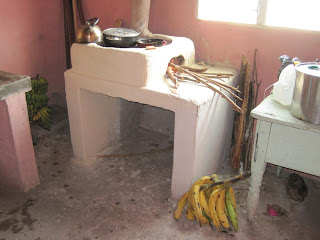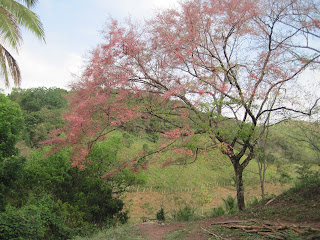The first two weeks of this month I participated in back to back medical brigades. I, along with three other NPH volunteers, was invited to serve as a translator and accompany a group of American doctors and dentists to an area called Montana de la Flor (Flower Mountain). We ventured hours and hours into the mountains along rugged dirt roads and across river beds to arrive at this extremely remote area where the people remain primarily indigenous and stricken with poverty. The brigade was comprised of about 70 people from the US military, Honduran military, a medical mission group of American dentists and doctors, a group of students from the South Dakota State University, a few Honduras doctors, and us translators. It was a very odd ensemble to say the least, and a lot of different people who thought they were in charge. But in the end, we were all there for the same purpose, to help people in need. I have to admit, I stopped and staired as much as the Honduran children did, when the military arrived in their convoy of humvys and began to unload. So we got to work… setting up base camp in the town community center and school, clinic by day and dormitories by night. The US military provided triage and talks on health and wellness education, the American doctors held general consults, the dentists pulled hundreds of teeth a day, and the students from SDSU did nutrition assessments both for the women and children who came to clinic and out in the field.
I worked mostly as a translator for the Nutrition and Food Access study that was being carried out by SDSU in collaboration with the Honduran ‘Ministry of Health.’ Every day teams of two students, a doctor, a US military personnel, a Honduran guard, and a translator would be sent out to find homes in the mountains that contained a randomly selected ‘index child’ to conduct the study on. The first day, our local guide was actually the chief of the village. The group hiked 1 ½ hours into uninhabited mountains, lugging scales, laboratory equipment, and personal gear to find a few clustered homes nestled into the hillside. The goal was to find a mother and child between 6 months and 5 years of age to participate in the study. In the homes we visited we would survey the family on food security and other family history data. Then collect data such as height, weight, arm girth, a physical assessment by the physician, and blood samples from the mother and baby to test for nutrition level and mineral levels such as Zinc, iron, Vit C, and Vit A. Those found to be anemic were then treated with iron and those underweight with a dietary supplement called plumpy-nut.
After a week of house visits and surveys, almost all the situations were the same. Most of the homes were made of mud walls with a dirt floor, no electricity, gathered water from the river, 5-6 children per family, mother nor father had never attended school, nor even knew how to sign their own name. Most families constantly worried about food supply or ran out, children were eating just one type of food every day if available, sometimes going all day without anything to eat, and going to bed hungry. Even after having traveled to many parts of the world and living in Honduras for over a year, this was some of the worst poverty I had ever seen. The first home that we visited that week was the worst, consisting of 4 poles holding up a roof of leaves with three tarps forming the walls. The only furniture in the house was a couple of tiny beds made of sticks stacked together and a few rags thrown on top. The 5 children walked around in tattered clothes, unkempt, caked in dirt head to toe, bellies distended from malnutrition. The mother stood by a pot of corn kernals cooking over a few logs of wood. Since her husband was away she did not consent to all of the study, but we were able to leave them with some soap, toothbrushes, clothing items and iron supplements.
It was an interesting dichotomy to visit this area, where because of their isolation they have managed to maintain their indigenous heritage and continue to pass down their culture and traditions such as their language ‘Tolpan.’ However the lack of influence from the outside world has also hindered their advancement in basic things such as electricity, water access, sanitation and cultivation of a value for education.
The day after I returned to the Ranch began another brigade held at NPH that I and another volunteer, Kate, helped to coordinate. Seven visiting doctors from Spain offered specialties of Gynecology, Pediatrics, and Family medicine. We offered consults for three days in the external clinic on the Ranch and the last day traveled to two very underserved and difficult to access communities. At both areas we held consults in the school house and pieced together a make-shift clinic and pharmacy. We were swamped by women and children seeking out medical services and treatment. But over the week, a lot of good was done seeing 120-150 patients per day.
Last weekend, the kids put on a talent show. While most talent shows I grew up watching consisted of a majority of singing numbers, here at NPH the kids much prefer to show off their dancing skills. I have always been impressed by how well the kids can dance here, and in a variety of different styles. I could name off any style of dance to a school-age child and they would most likely be able to dance the correct steps (Bachata, Merangue, Salsa, Punta, Ranchero, even Rock&Roll and Disco). A group of the youngest girls showed off their talents with a hula-hoop, some even able to do dance steps while twirling the hoop around their waist. The girls in my hogar self-choreographed a dance to an entire song on their own, with 12 of them actually getting up the courage to perform it.
Today I returned back to the Ranch from a quick weekend trip to visit an area called Santa Barbara. After about 6 months of attempted planning, I and my two favorite caregivers for the girls in Hogar, Carmen and Lizeth, were finally able to make this trip a reality. Lizeth and I traveled about 5 hours north-east to visit the home of Carmen and her family. She lives in a modest house out in the country with her husband, two young children, 15 dairy cows, 4 dogs, 2 pigs, a handful of chickens, and a rabbit. It was a great weekend, both to relax and get away, and also to learn what it is like to be a homemaker in Honduras. There was time for some fun as well as we got to spend the afternoon playing in a river, followed by a hot springs in the evening that curiously spouted out of a pipe on the side of the highway.
I feel I would be very inadequate if I ever wanted to marry and run a household in Honduras. I learned many new tasks this weekend such as cow milking (very tiring by the way if you haven’t developed the right muscles in your hand and forearm), corn tortilla making, how and what to feed pigs, and how keep children and a husband happy. Carmen is able to maintain the household in a very sustainable way, in that the majority of the staple foods her family eats come from their property. The milk, cream, and cheese comes from the cows, eggs and meat from the chickens, beans are grown in the garden, not to mention the huge variety of fruit trees on their property. When it was blazing hot in the mid-day sun, Carmen said “I think some lemonade would be good right about now” and she went out into the back yard and plucked the limes off the tree. One of the things Carmen told me this weekend that had a lot of meaning was “It is possible, with some hard work, to live a comfortable and happy life on very little.”
All packed and ready to go on the Montana de la Flor brigade, where we volunteered as medical translators.Hiking up the mountain to selected home sites with all of the survey gear, military personelle and students.
Typical 1 room mud and stick home in the village of Rincon.
The first home we visited, Maria Luisa with her five children. The boy in the middle demonstrating the typical fashion for carrying babies and toddlers in a cloth sling.
Typical handicrafts made by the Montana de la Flor women.
One of the little girls we surveyed, showing off her bandaided fingers after we took a blood sample to measure her nutrition status.
One of the National Guard members teaching the local children handwashing technique in the river.
Daytrip away from NPH, we converted a one-room school house into a make shift clinic for the brigade of Doctors from Spain.
Deedee and I ran the admission, vital signs, and pharmacy at a few tables out front of the school.
Jen, my fellow volunteer nurse, and I in the back of a pick-up truck on our way to the remote village of Las Pilas to attend to the medical needs of the community.
One of our youngest (and cutest) patients.
The little girls (ages 4-6) putting on a hula-hoop performance for the talent show.
A day hanging out with the girls... Cathi and Carmen.
A typical way of cooking in most Honduran households with a wood-fueled fire below a large metal plate, where pots, pans, and tortillas can be heated.
The view of the property at Carmen's home.
The "Pila." A normal fixture in most honduran households that serves as a water container for the daily water use of the household. The scrubing board attached serves a variety of functions such as clothes washing, dish cleaning, handwashing, and teethbrushing.
Playing in the field with Carmen's daughter Valeria (5 years).
Learning how to make corn-flour tortillas. First you have to make a ball and get it as even and flat as possible.
Then you place it gently on the comal (stove surface) being careful not to let it burn.
Learning to milk a cow, not as tedious as I thought, but definately tiring.
Enjoying the hot springs.





































